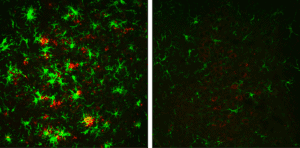Researchers at the Cleveland Clinic, VIGILINT’s collaborator on our GMAP program, have found a major breakthrough in the fight against Alzheimer’s Disease.
The study was led by Riqiang Yan,Ph.D and found that inhibiting BACE1, the beta-secretase enzyme active in Alzheimer’s Disease in adult mice halted the generation, and in some cases reversed the buildup of the amyloid plaque associated with Alzheimer’s Disease. Published in the Journal of Experimental Medicine, the observation is believed to be the first complete reversal of amyloid plaque deposits by removing the BACE1 enzyme in the early stages of the disease.

In addition to Alzheimer’s Disease, the presence of amyloid plaques or amyloid-like structures have been found in Huntington’s Disease and Parkinson’s Disease with Dementia. The Cleveland Clinic study cautions that some levels of BACE1 are required for optimal cognitive function, and recommends follow up studies to determine optimal treatment plans.
In 2017, 5.5 million Americans were living with Alzheimer’s dementia. An estimated 5.3 million were over the age of 65, while roughly 200,000 lived with a younger-onset Alzheimer’s.
Dave Thompson MPAS, PA-C, VIGILINT’s Deputy Chief Medical Officer commented: “The Clinic’s recent work in BACE1 inhibition in Alzheimer’s disease is the latest example of the consistent groundbreaking research conducted by our partners. This work continues to benefit our nation and the world, and we at VIGILINT look forward to learning more about this exciting research as trials continue.”
The Cleveland Clinic study shows promising findings in animal subjects with a devastating genetic disease. Five BACE1 inhibitor trials are currently underway in humans.
